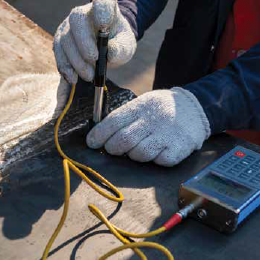COURSE INFORMATION
Eddy Current Testing (ECT) is a highly effective electromagnetic testing method that leverages electromagnetic induction to detect and assess discontinuities in materials. A fundamental prerequisite for eddy current testing is that the material being examined, or in the case of paint thickness measurement, the substrate, must be electrically conductive.
ECT serves as a versatile testing method, offering both surface and subsurface inspection capabilities. The depth to which inspections can be carried out effectively hinges on several factors, including the frequency of the excitation current, the electrical conductivity, and the magnetic properties of the material under scrutiny. While this may seem complex, it all boils down to principles you may recall from your high school lessons on electrical transformers.
If the world of electromagnetic induction intrigues you, dust off your high school knowledge and embark on an ECT course. It’s a journey that promises to deepen your understanding and expertise in this captivating field.
Eddy current testing techniques are adaptable, depending on the nature of the sample being tested, be it a flat surface, tube, bar, or more intricate shapes. The choice of probe is influenced by this, and it plays a pivotal role in the testing process. Additionally, the utilisation of multiple frequencies and inspection modes, such as absolute or differential, determines the specific multi-frequency and/or mode techniques used.
The presence of factors like magnetic saturation, weak magnetic alloys, shielding, or the focusing nature of the probe, as well as the capabilities of the display system, contribute to the comprehensive description of eddy current testing techniques. By delving into Eddy Current Testing, you’re not only exploring the intriguing world of electromagnetic induction but also contributing to the safety and quality assurance of materials in various industries.
IF THIS SOUNDS LIKE A MOUTHFUL, THEN WE INVITE YOU TO DUST OFF YOUR HIGH SCHOOL KNOWLEDGE REGARDING ELECTRICAL TRANSFORMERS AND ATTEND AN ECT COURSE.
The techniques utilised in eddy current testing depends on the sample being tested, i.e. whether it is a surface, tube, bar or other more complex shapes since it dictates the type of probe to be used. Furthermore, the number of frequencies and the inspection mode(s), such as absolute or differential, determines the multi- frequency and / or mode technique description. The presence of magnetic saturation, weak magnetic alloys, shielding or focussing nature of the probe as well as the display capabilities extends the technique description.
The training course is based on general theory as well as sector specific applications relating, but not limited to, the following standards and specifications:
- ASME Boiler & Pressure Vessel Code – Section V – Subsection A – Article 1 & 8
- ASME Boiler & Pressure Vessel Code – Section V – Subsection B – Article 26
- ISO 15549 ECT – General principles
- ISO 15548 Part 1 ECT – Instrument Characteristics and verification
- ISO 15548 Part 2 ECT – Probe Characteristics and verification
- ISO 15548 Part 3 ECT – System Characteristics and verification
- ISO 17643 ECT – Welds
- ISO 2360 ECT – Non-Conductive coatings – Amplitude sensitive equipment
- ISO 21968 ECT – Non-Conductive coatings – Phase sensitive equipment
- ISO 12718 ECT – Vocabulary
Dates
| EDDY CURRENT TESTING – SAIW CERTIFICATION NDT SCHEME (ISO 9712) NON-DESTRUCTIVE TESTING – SURFACE METHOD | ||||||
| NDT Method and Level | Industrial Sector | Product Sector /Category | Duration 1 day =8 hours | Course Code | ECT 1.1 - JHB 01 | ECT 1.2 - JHB 01 |
| Eddy Current Testing Level 1 | Pre- and in-service | ECT 1.1 Surfaces (s) | Training 4 days | Training | 02 - 05 Jun | 30 Jun - 03 Jul |
| ECT 1.2 Tubes(t) | Exam 1 day | Exam | 06 Jun | 04 Jul | ||
| NDT Method and Level | Industrial Sector | Product Sector /Category | Duration 1 day =8 hours | Course Code | ECT 2.1 - JHB 01 | ECT 2.2 - JHB 01 |
| Eddy Current Testing Level 2 | Pre- and in-service | ECT 2.1 Surface (s) | Training 4 days | Training | 07 - 10 Apr | 11 - 14 Aug |
| ECT 2.2 Tubes (t) | Exam 1 day | Exam | 11 Apr | 15 Aug | ||
Costs
| Prices (inclusive of VAT) | |||
| NDT Method and Level | Training & Initial Examination Non-Corporate Members | Training & Initial Examination Corporate Members | Initial Certification |
| Eddy Current Testing Level 1 - ECT 1.1 | R16,100 | R15,000 | R2,500 |
| Eddy Current Testing Level 1 - ECT 1.2 | R16,100 | R15,000 | R2,500 |
| Eddy Current Testing Level 2 - ECT 2.1 | R16,100 | R15,000 | R2,500 |
| Eddy Current Testing Level 2 - ECT 2.1 | R16,100 | R15,000 | R2,500 |
Email : ndt@saiw.co.za
Download Eddy Current Testing (ECT) Details Download NDT Course Application Form



